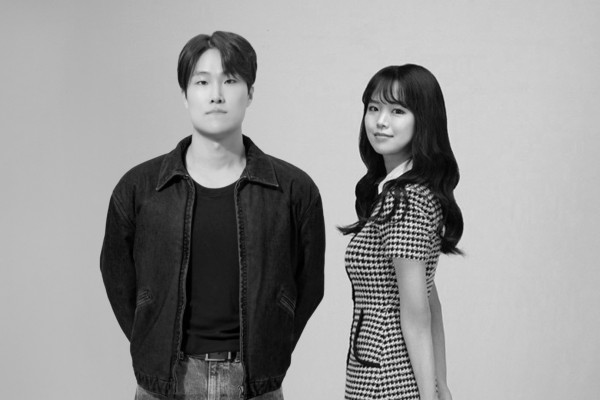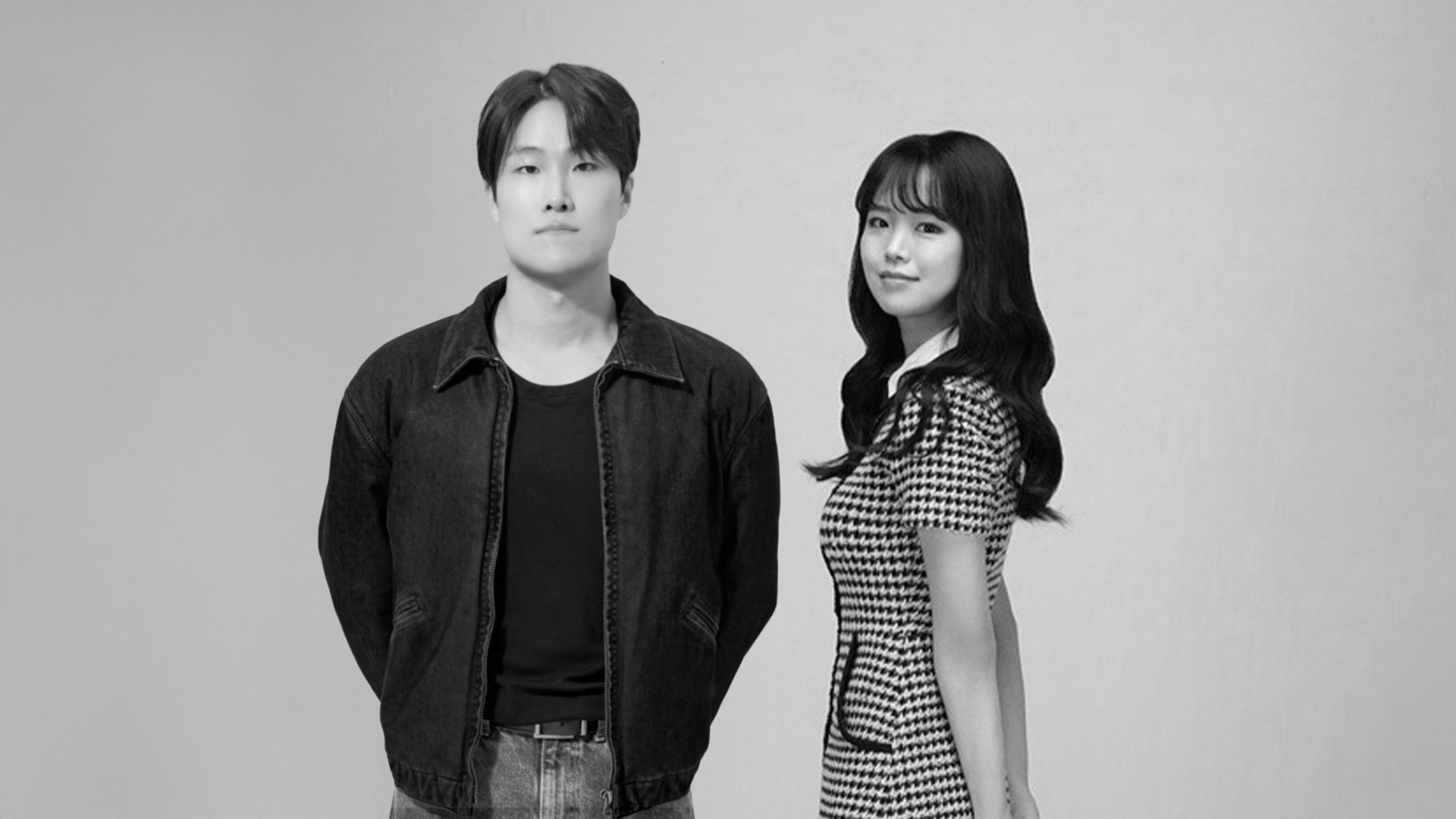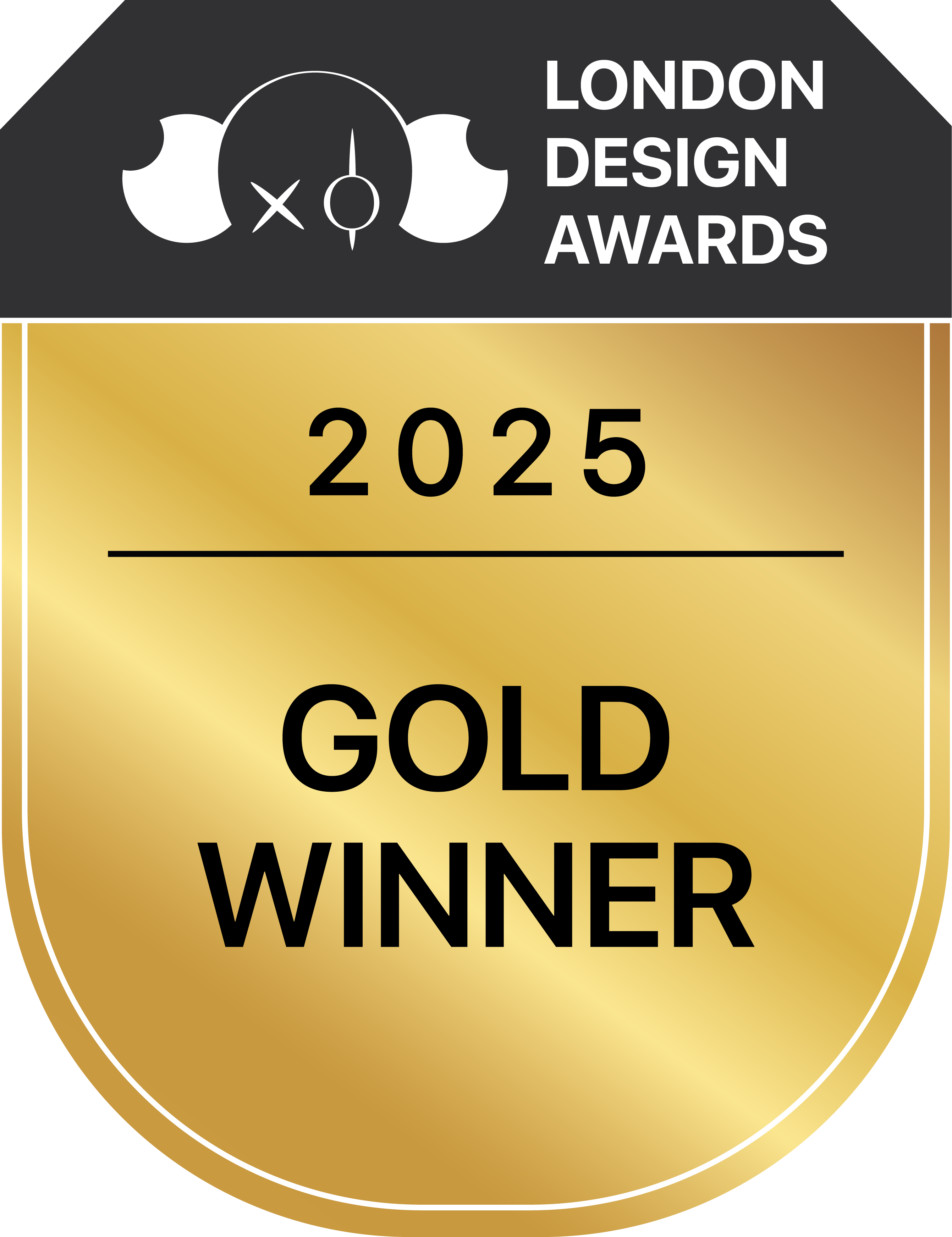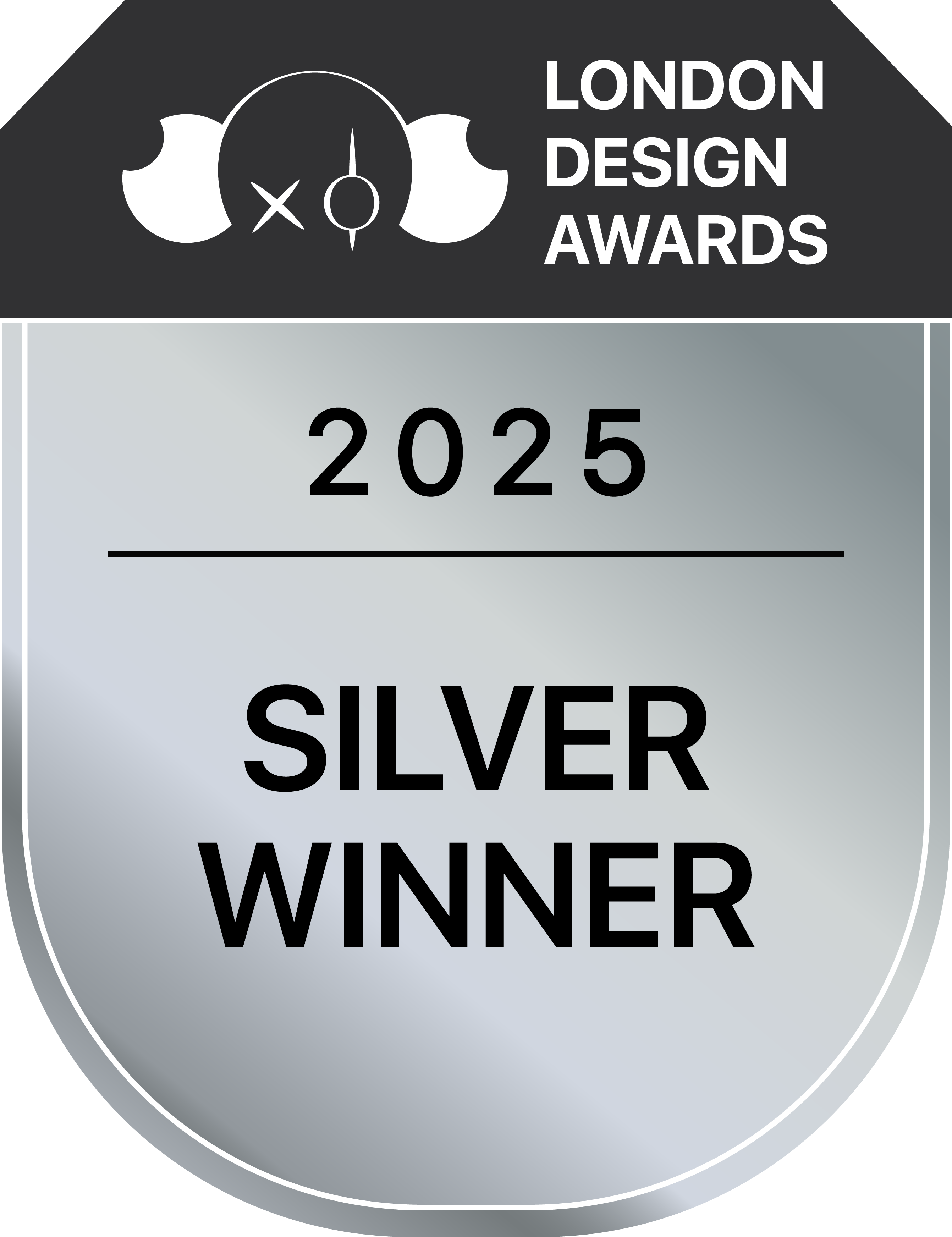
Songwon Kim & Sanghwan Lee
1. Congratulations on winning the London Design Awards! Can you introduce yourself and share about what inspired you to pursue design as a career?
Songwon Kim: I’m Hailey Songwon Kim, a Seoul-born, New York-based graphic and brand designer. Influenced by my architect mother, art and design surrounded me from an early age–galleries, cityscapes, and studio visits were our usual itinerary. I began in fine arts, but gradually gravitated toward design’s subtle power to shape daily behaviour–from the crease of a carton to the cadence of type.
That fascination led me to complete a master’s degree in Visual Communication Design at the School of the Art Institute of Chicago, and today I craft cross-cultural brand stories at KISS USA, turning insights into identities that make everyday interactions intuitive and meaningful.
Sanghwan Lee: I grew up across cultures—South Korea, Arizona, Dubai, Indonesia, and now New York. Early on, I struggled with language, which taught me that communication isn’t just verbal. That’s how I became drawn to visual storytelling.
Experiencing different cultures shaped my perspective and deepened my interest in design that connects instinctively. I studied Advertising at the School of Visual Arts to develop that ability further, and now work at Kiss Products, focusing on packaging as a tool for meaningful consumer connection. My goal is to create a design that feels natural, inclusive, and emotionally resonant—no translation needed.
2. What does being recognised in the London Design Awards mean to you?
Songwon Kim & Sanghwan Lee: Being recognised by the London Design Awards feels like a meaningful affirmation that thoughtful design—design that prioritises experience, accessibility, and cultural relevance—matters. As designers, we often question whether the ideas we pursue resonate beyond our own perspectives.
This recognition reminds us that the values we care about—making design more inclusive, playful, and socially connective—can be shared and appreciated by a wider audience. It’s not just a milestone for us, but a moment that makes us feel seen as part of a larger design conversation. It encourages us to keep creating with empathy and intention.
3. How has this achievement impacted your career, team, or agency, and what opportunities has it brought so far?
Sanghwan Lee: Receiving recognition for both Minimix and Re:leaf at the London Design Awards has been a defining early milestone in my career. These were among the first projects where I had full creative ownership—from concept to execution—and the experience of seeing them resonate internationally has been both grounding and motivating.
It reaffirmed that the ideas I care about—design that challenges convention, invites interaction, and considers sustainability—have real relevance beyond the studio.
Professionally, it’s helped build credibility, sparked new conversations, and opened up opportunities for more collaborative and experimental work. More than anything, it’s laid the foundation for how I want to move forward as a designer—with purpose, clarity, and curiosity.
4. What role does experimentation play in your creative process? Can you share an example?
Songwon Kim & Sanghwan Lee: Experimentation powers our workflow—we treat every concept as a hypothesis that must survive a gauntlet of hand‑folded prototypes before any 3D modelling begins. We sketch a quick dieline, grab whatever’s on hand—printer paper, discarded packaging, even take‑out coffee cups—and start cutting, taping, and refolding. Each round reveals new nuances, and the idea often drifts far from the original plan.
With re:leaf, we started with a simple pot‑shaped wet‑wipe container and asked: could the pack itself advance the sustainability story rather than just look appealing? That led us to an accordion structure that expands in use and collapses when empty. Through dozens of paper trials, we tweaked fold counts and spacing until the motion felt smooth, the optimal volume was set, and material waste was minimal.
Minimix—our single‑serve cocktail pouch that tears open into a self‑standing cup—went through a similar iterative grind. We tested multiple pouch sizes, ratios, and carton configurations until fit, access, and overall experience clicked. In parallel, we translated each cocktail into bold colour‑blocked graphics, cycling through palette and typeface tests until the system felt cohesive, legible, and inviting.
Quick‑scan infographics for mixing ratios were prototyped as well. By layering structural tweaks with graphic refinement, we achieved a design that’s intuitive, playful, and primed for spontaneous gatherings.
5. What's the most unusual source of inspiration you've ever drawn from for a project?
Songwon Kim: The strangest—and most rewarding—material I’ve ever worked with was Chicago River water dyed neon‑green for St. Patrick’s Day. While developing Ephemera, a project that archives overlooked, vanishing moments, I realised the river’s famous hue fades so gradually that most people never notice it returning to clear.
Determined to capture that transition, I scooped a test‑tube sample every day for several weeks, labelled each vial, and photographed the colour shift. Those tiny cylinders became both a chromatic timeline and a meditation on how quickly “extraordinary” turns back into “everyday.”
Alongside the water, I catalogued lint, snack wrappers—anything destined for the bin—transforming household residue into a tactile archive of passing time.
An earlier piece, Hair is Still Recording, took inspiration from strands of human hair. Treating hair as living “tree rings,” I built an interactive installation where motion sensors triggered light and motors, revealing how personal data is silently stored on our bodies.
I’m constantly drawn to materials we overlook because they remind me that inspiration hides in plain sight, waiting for someone curious enough to record it.
6. What’s one thing you wish more people understood about the design process?
Sanghwan Lee: I wish more people recognised that good design isn’t always meant to stand out—it’s often meant to disappear into the experience. Aesthetics matter, but for me, design is ultimately about creating something that feels intuitive, effortless, and enjoyable.
The most effective solutions are sometimes the ones people don’t consciously notice, because they just work. I believe design should solve real, everyday problems in a way that feels natural, even delightful. When design becomes part of someone’s routine without friction, that’s when it’s truly doing its job. I hope more people see the beauty in that kind of quiet impact.
7. How do you navigate the balance between meeting client expectations and staying true to your ideas?
Sanghwan Lee: Client goals always come first—I see design as a service, and it’s my role to help bring their vision to life. But when our perspectives don’t fully align, I try to find a middle ground through dialogue and exploration.
If that still doesn’t lead to clarity, I often present two routes: one that directly reflects the client’s request, and another that meets their objectives while pushing the design further. Visuals speak louder than explanations, and I’ve found that showing rather than telling is often the most effective way to build trust and open up new possibilities.
8. What were the challenges you faced while working on your award-winning design, and how did you overcome them?
Songwon Kim & Sanghwan Lee: We never lack fresh ideas–our kick-off boards are always bursting with clever shapes and playful mechanics–but the real battle begins when those sketches leave the page. As soon as we translated the concept into physical form, structural and material flaws emerged: folds that refused to align, paper stocks that split, finishes that wouldn’t hold adhesion. Every promising mock-up uncovered a new weak point.
Our solution was relentless iteration. We cranked out scores of prototypes for both Minimix and re:leaf, testing every fold, tear, and material we could get our hands on. Even when a version seemed “finished,” we asked if it could be sturdier, more practical, or visually sharper–sometimes scrapping near-complete models to start over. That cycle of make-test-refine turned a pile of experiments into two designs we were confident were truly production-ready.
9. How do you recharge your creativity when you hit a creative block?
Songwon Kim: When a project stalls, I head out to connect with people and spark conversation. Talking with friends, neighbours, or even strangers on the subway lets the brief leave my head and return as a shared story; their off‑hand questions or tangential anecdotes often reveal angles I’d never reach alone.
Because I draw energy from social interactions, these spontaneous exchanges recharge me faster than any solo sketch session, and it’s usually mid‑dialogue, when ideas start ricocheting, that the solution clicks into place.
10. What personal values or experiences do you infuse into your designs?
Songwon Kim: Empathy and communication guide everything I create. I focus on revealing the invisible values—memories, emotions, subtle social cues—that often go unspoken, then translate them into forms that spark dialogue.
A life threaded through Seoul, Chicago, and New York sharpened my sense of cross‑cultural empathy, so I weave multiple perspectives into each visual choice. By infusing these values into my work, I aim to craft designs that connect people more deeply to both one another and the stories around them.
11. What is an advice that you would you give to aspiring designers aiming for success?
Songwon Kim: Brainstorm wide and early—put every half‑baked idea on the table and resist the urge to shoot anything down too soon. Perfect concepts rarely appear at the sketch stage; if you start by listing flaws, you’ll talk yourself out of making anything at all.
Instead, let ideas breathe, prototype quickly, and then critique what you can see and touch. You’ll discover which directions have legs, which need tweaks, and which should be retired—without smothering the creative spark before it even lights.
12. If you could collaborate with any designer, past or present, who would it be and why?
Sanghwan Lee: I’d love to collaborate with someone like Naoto Fukasawa. His approach to design—quiet, intentional, and deeply human—has always resonated with me. He once said that the best designs are those that dissolve into behaviour, and I relate to that idea deeply.
I admire how he designs not to impress, but to integrate—to make things feel natural, almost inevitable. I think a collaboration with someone who sees the beauty in the ordinary, and who designs with empathy and restraint, would challenge me to think even more critically about how design lives in the everyday.
Songwon Kim: I’d choose Dieter Rams. I’ve always admired—and personally loved—how his “Less, but better” approach pares objects down to their purest, most human function.
Collaborating with him would push me to refine every element until clarity and usefulness are inseparable, a discipline I deeply respect as a designer. Learning firsthand how he balances restraint with warmth would be an invaluable masterclass in purposeful simplicity.
13. What's one question you wish people would ask you about your work, and what's your answer?
Sanghwan Lee: I wish more people would ask, “How do you want people to feel when they interact with your design?” Because to me, design is never just visual—it’s emotional. I care less about whether someone notices the design, and more about whether they feel understood, at ease, or even a little surprised.
If my work can make someone’s day feel smoother or shift how they experience something familiar, then that’s the kind of impact I’m proud of. Beauty is important, but empathy is what makes design meaningful.




